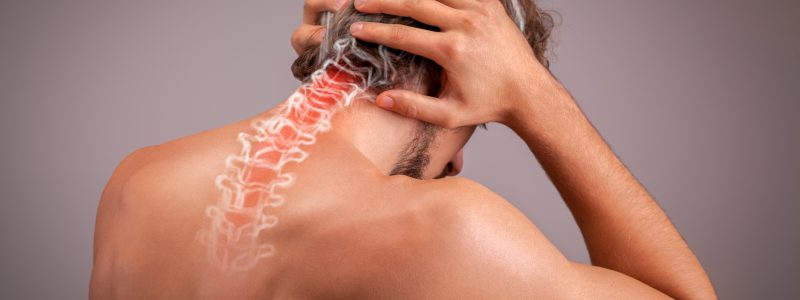Neck Pain

What is neck pain?
The neck is made up of the first 7 vertebrae of spine, including ligaments and muscles. It’s main role is to support the heavy weight of the head and allow movements such as nodding and shaking of the head. As you can imagine, this is a tough role for the neck.
Neck pain can present as acute, sub- acute and chronic in nature and can be related to an injury or just the stress of the type of lives that we live. Neck pain will affect most people at some point in their life and is usually short lived and not all presentations will develop into a chronic problem.
Usually neck pain that does not go away by itself will require a full assessment from a health care practitioner.
What causes neck pain?
Neck pain affects approximately 10% of the population at any one time and statistically women are more likely to suffer with neck pain than men, with the onset being approximately 45 years of age for women and 60 years for men.
There have been a number of studies undertaken into the risk factors of developing chronic neck pain and these are identified as ‘yellow flags’.
For women, the yellow flags are identified as:
- High physical workload
- Intermediate and high work releated emotional exhaustion
- Common mental health disorders such as depression
- Rare to occasional sleep problems
- Overweight and obesity
For men, the yellow flags are identified as:
Presence of chronic low back pain
- Previous acute neck pain
- Manual class worker compared with managers and professionals
- High work related stress and exhaustion
- Frequent sleep problems
Our lifestyle plays a huge role in the development of neck pain and these are some of the conditions that may be causing your neck pain. It is important that you seek professional help for your neck pain so the correct diagnosis and management can be given to you:
- Traumatic neck injury such as whiplash affected disorder (WAD)
- Acute cervical torticollis also known as wry neck
- Cervical facet syndrome (inflamed cervical facet joints)
- Discogenic or disc bulge with or without arm/shoulder pain and weakness
- Muscle strain or sprain
- Osteoarthritis
- Postural related neck pain such as ‘text neck’
- Other more sinister pathology related neck pain such as vascular emergencies or infection
What will the Chiropractor do?
Chiropractors spend 5 years full time at University learning how to comprehensively assess and diagnose the underlying cause of neck pain. Chiropractors, if they deem necessary, are also qualified to refer you for further imaging such as x-ray or MRI to assess the structure of the neck which may be contributing to the incidence of neck pain.
At your Initial Consultation, Niki will take a thorough history of your case and undertake an in depth physical examination to rule out any need to send you for further investigations. Most commonly, neck pain presentation in the Chiropractic office is based around facet (joint) dysfunction and does not require any imaging.
Our goal as Chiropractors is to encourage free movement of the joints within the neck to allow the swelling to dissipate and aid in muscle relaxation around those joints, ultimately resulting in a reduction of pain.
Niki has built a strong reputation for her low force, gentle treatment of neck pain. This type of treatment can bring some relief to those who might be nervous of seeing Chiropractor and who do not like to have their neck manipulated.
Common fears of Chiropractors treating neck pain?
We understand that many patients worry about having their neck manipulated and this is a valid concern of ours also. Research has shown inconclusive evidence that manipulation alone can assist in chronic neck pain. This is why we use this method cautiously.
The good news is, we have many options to treat neck pain other than cervical manipulation. In practice we find the combination of the Activator Methods along with dry needling of the muscles can bring a positive result for chronic neck pain sufferers. If you would like to know more about the activator method technique, please see their website: www.activator.com
That being said, some patients do prefer cervical manipulation and so Niki offers both Activator Method and manual therapy for cervical facet dysfunction and it really depends on your comfort levels. Niki will always let you decide if you prefer Activator or Manipulation and she will obtain your verbal and written consent prior to any treatment.
Please note, Niki does not offer manual cervical manipulation for patients who have a history moderate to severe vascular disease, are over the age of 65 or who are under the age of 12 years old.
- www.myvmc.com/diseases
- ‘The prevalence of neck pain in the world population: a systemic critical review of the literature’ Fejer, Kyvik and Hartvigsen; 2006 cited in www.ncbi.nlm.nih.gov.au
- ‘Clinical Perceptions of the risk of vertebral artery dissection after manipulation: the effects of referral bias’; Haldeman, S 2002; cited on www..ncbi.nlm.nih.gov
- ‘Risk of vertebrobasilar stroke and chiropractic care’ Cassidy, Boyle, Bondy 2008 cited in www. Ncbi.nlm.nih.gov
Booking with us
If you would like to book an appointment with us, just click the book appointment link or call/text 0434 059 242.
